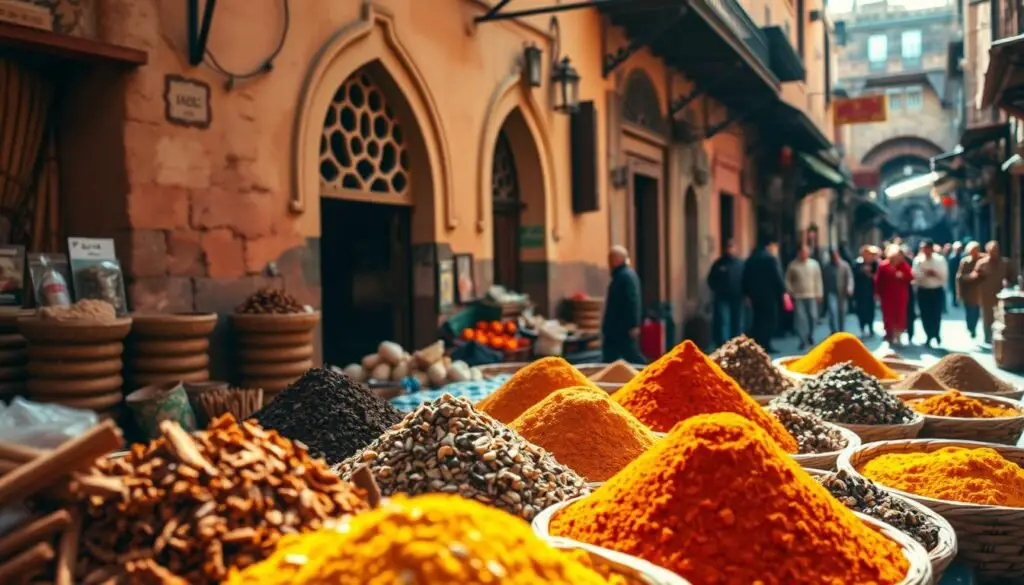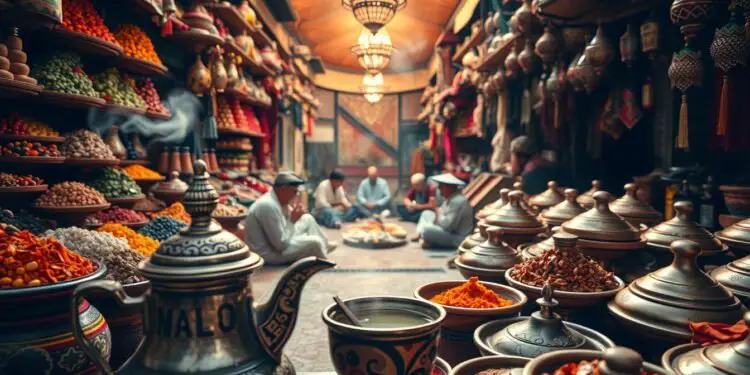What makes a country’s food more than just a meal? In Morocco, every dish tells a story—one woven through centuries of history, geography, and shared moments around the table. From bustling markets to quiet family gatherings, the way people eat reflects the heart of their culture.
This North African nation stands at a crossroads of flavors, blending Arab, Berber, and Mediterranean influences. The result? A vibrant cuisine recognized by UNESCO for its global significance. Meals here are more than sustenance—they’re celebrations of connection.
Picture steaming tagines served on low tables, fragrant mint tea poured with precision, and communal bowls that bring people closer. These customs highlight Morocco’s deep-rooted hospitality and the artistry behind every bite.
Key Takeaways
- Morocco’s food blends Arab, Berber, and Mediterranean influences.
- UNESCO recognizes its cuisine for cultural importance.
- Communal eating strengthens family and social bonds.
- Tea ceremonies symbolize hospitality and tradition.
- Spices like cumin and cinnamon define its bold flavors.
Historical Roots of Moroccan Culinary Traditions
Centuries of cultural exchange shaped the vibrant tastes found in Moroccan kitchens. The country’s dishes reflect a mosaic of Berber, Arab, and Mediterranean influences, each adding layers of flavor and technique.

Berber and Arab Foundations
Berbers, the indigenous people, laid the groundwork with grain-based meals like couscous. They used local wheat and barley, slow-cooked in tagines. Arabs later introduced spices like cinnamon, saffron, and cumin through trade routes.
These blends transformed simple dishes into aromatic feasts. Saffron from Talaouine became a prized ingredient, cultivated by Berber farmers for generations.
Jewish and Moorish Contributions
Jewish communities perfected preservation, pickling lemons and salting meat (khlea) for longevity. Moors from Spain brought olives, citrus, and dishes like b’stillah—a sweet-savory pigeon pie.
Their techniques ensured food survived long trade journeys. Pickled flavors still define many recipes today.
Colonial Impacts on Modern Cuisine
French rule left cafés and wine culture in cities. Spanish influences appear in northern seafood dishes. Even social hierarchies shaped meals—luxury spices were once reserved for elites.
From Berber farms to colonial cafés, every era added something new. The result? A cuisine as rich in history as it is in taste.
Key Ingredients and Spices in Moroccan Cuisine
The foundation of every great dish lies in its core components—the oils, fats, and spices that bring it to life. These elements transform simple meals into rich, layered experiences. From the golden hue of olive oil to the deep funk of aged butter, each ingredient tells a story.
Olive Oil, Preserved Butter, and Other Staple Fats
Olive oil varies by region. Meknes produces fruity, mild varieties, while Marrakech’s oil is robust and peppery. Both are staples in salads and dips.
Smen, or aged butter, adds umami depth to tagines. Salted and fermented for months, it’s a traditional preservative with a bold flavor. Argan oil, pressed by women’s cooperatives, is drizzled over bread or used in dressings.
The Magic of Ras El Hanout and Other Signature Spices
Ras el hanout, meaning “head of the shop,” is a prized blend of 7-30 spices. Cinnamon, cloves, cardamom, and cumin create its warm, complex profile. Each household guards its unique recipe.
Saffron from Taliouine, ginger, and turmeric are essentials. Turmeric doubles as a medicinal ingredient, often added to stews. Preserved lemons, packed with salt and spices, brighten tagines and salads.
Harissa, made with local chilies, ranges from fiery to floral. A rose petal version adds subtle sweetness. These ingredients showcase the artistry behind Moroccan cooking.
Iconic Moroccan Dishes and Their Cultural Significance
Every bite of Moroccan food carries a story of heritage and shared moments. From Friday family gatherings to festive street stalls, each dish reflects centuries of tradition and community.
![]()
Couscous: The National Dish of Morocco
Steamed to perfection, couscous is more than a meal—it’s a Friday ritual. Families gather around heaping plates of seven-vegetable couscous, symbolizing unity and gratitude. Berber farmers originally crafted this dish from durum wheat, now a UNESCO-recognized staple.
Coastal towns add seafood, while inland regions prefer lamb or raisins. The communal act of eating from one platter strengthens bonds, turning meals into celebrations.
Tagine: A Slow-Cooked Symbol of Hospitality
Named after the clay pot it’s cooked in, tagine embodies Moroccan warmth. Slow-cooked over charcoal, blends like lamb with prunes or chicken with olives vary by region. In Marrakech’s Djemaa el-Fna square, vendors serve sizzling versions late into the night.
Essaouira’s seafood tagine highlights coastal adaptability. The dish’s tender meat and aromatic broth make it a centerpiece at weddings and holidays.
Beyond these staples, bread kneaded in village bakeries and b’stillah’s sweet-savory layers reveal deeper cultural fusions. Street snacks like snail soup or harira during Ramadan further showcase Morocco’s edible artistry.
Conclusion
The world is discovering bold flavors shaped by geography and trade. From Berber farms to global kitchens, each dish reflects a balance of heritage and innovation. Modern chefs like Choumicha showcase these tastes while honoring traditional methods.
For authentic experiences, skip tourist restaurants. Visit cooperative kitchens where people craft argan oil or ras el hanout. Sip tea poured with care—its frothy top symbolizes hospitality.
UNESCO’s Mediterranean diet designation celebrates this living legacy. As demand grows for spices and oils, remember: every bite connects you to a story centuries in the making.
FAQ
What makes Moroccan food unique?
The blend of Berber, Arab, and Mediterranean influences creates bold flavors. Spices like cumin and ras el hanout, along with slow-cooked dishes like tagine, define its distinct taste.
Why is olive oil so important in Moroccan cooking?
Olive oil is a staple fat used for frying, dressing, and marinating. It adds richness and depth to dishes while reflecting the country’s agricultural heritage.
What role does mint tea play in Moroccan culture?
Mint tea symbolizes hospitality and is served throughout the day. Its sweet, refreshing taste makes it a social ritual, often paired with bread or pastries.
How did Jewish traditions influence Moroccan cuisine?
Jewish communities introduced preserved lemons, slow-cooked meats, and dishes like tfaya. These flavors became integral to the country’s food culture.
Is Moroccan food spicy?
While flavorful, it’s not typically fiery. Spices like saffron and ginger add warmth, but heat levels are milder compared to other global cuisines.
What’s the difference between couscous and tagine?
Couscous is steamed semolina served with vegetables or meats. Tagine refers to both the clay pot and the slow-cooked stew inside, often featuring lamb or chicken.




